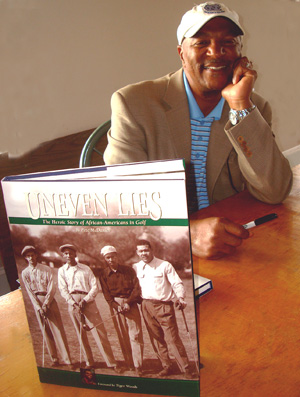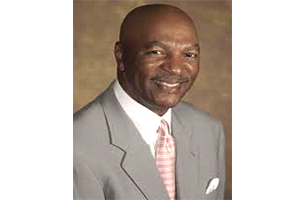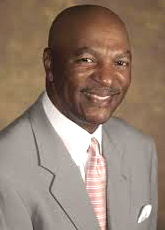 Pete McDaniel
Pete McDaniel
Contributing Editor
African American Golfer’s Digest
Blog: March 2013
When I arrived in Trumbull, Ct., in late summer of 1993, I brought with me 15 years of sports writing experience, 30 years of playing experience (including high school and college golf) and a unique perspective which I thought would be an asset to Golf World Magazine’s coverage of the game. I also unpacked a severe case of the yips.
For the uninitiated, the yips are involuntary movement of the hands/wrists during the putting stroke (although I later learned from celebrated instructor Hank Haney, my fellow collaborator on Tiger Woods’ tips for Golf Digest, that the yips can infect the full swing, as well). The embarrassingly frequent attacks of flinching at impact nearly drove me from the game. At their worst, I couldn’t hole a foot-long putt.
I tried everything to rid myself of this most dreaded and sometimes deadly (to one’s game) disease, from a left-hand-low style of gripping the putter to practicing with my eyes closed to gripping the putter an inch above the hosel (I looked like an anteater scanning the green for lunch). For a period, when I was still playing in the gangsome and making side bets at Asheville (N.C.) Muny, I spelled relief B-U-D-W-E-I-S-E-R. That’s right. I’d pop the top on a cold one on the first tee. It seemed to calm my nerves early in the round, but, eventually effects of the alcohol would wear off and the yips would be exacerbated. After 18 holes I’d be both drunk and broke. Thus my career as a hustler was short-lived.
It got so bad that even my fellow competitors felt sorry for me. “Pick it up, McD, before you hurt yourself,’’ they’d say sometimes in mock sympathy. Sadly, my reputation at Golf World and Golf Digest was that of a pretty fair ball-striker, who could hit more greens than he missed but still shoot 85. That’s because I’d have a number of three-putts and perhaps even a four-putt or two.
My savior resided in a corner office reserved for the president and chief executive officer of The New York Times Company Magazine Group, which owned Golf World and Golf Digest and a number of other titles. His name is Jay FitzGerald.
 Jay had been a top flight amateur most of his golfing career. He had also been afflicted with the same putting disease, so his empathy was genuine when he heard about the staffer with the terrible case of the yips. He called me into his office and regaled me with horror stories about the affliction, including one about a fellow who had the yips so bad that he literally trapped the ball with the putter-head against his left foot while attempting to putt. I didn’t know whether to laugh or cry because I could feel the guy’s pain. Then he handed me a long putter, the kind where you anchored (there’s that forbidden word) the shaft under your left arm.
Jay had been a top flight amateur most of his golfing career. He had also been afflicted with the same putting disease, so his empathy was genuine when he heard about the staffer with the terrible case of the yips. He called me into his office and regaled me with horror stories about the affliction, including one about a fellow who had the yips so bad that he literally trapped the ball with the putter-head against his left foot while attempting to putt. I didn’t know whether to laugh or cry because I could feel the guy’s pain. Then he handed me a long putter, the kind where you anchored (there’s that forbidden word) the shaft under your left arm.
Of course, I resisted using the long putter because of the scrutiny mainly. What little pride I had left would surely take a beating from my colleagues. It would also mean that I was a failure. For a guy who had been blessed with substantially more successes than failures that would have been a bitter pill. But I eventually swallowed it and, with practice (much practice) I learned how to use that long putter effectively. More importantly, though, my fun quotient—the main reason most amateurs, including myself, play the game in the first place—dramatically improved. I was back. Any doubters need only test me. I have a long list of victims who will testify to the strengths of my game—driving, bunker play and, yes, putting. Sadly, the yips worked their way into my chipping (I’ve had chipping tips from every noted instructor; even one from Tiger himself; nothing’s helped) but that’s another story.
The moral of this story lies in knowing that I can compete again and also enjoy the game every time I tee it up, win or lose. It is through that prism the current debate over the USGA’s decision to ban anchoring in putting should be viewed. Golf industry leaders have been strong advocates of growing the game. That provided the impetus of The First Tee, Golf 20-20 and other initiatives aimed at getting more young people involved in the game and retaining those already hooked by its mysteries. Even though the ban wouldn’t go into effect until 2016, the debate is a hot-button issue with various forces drawing a line in the sand.
PGA Tour Commissioner Tim Finchem recently weighed in during a press conference at the match play event in Arizona. In essence, Finchem, pushed the tour players’ consensus disagreeing with the proposed ban. Finchem said that where the PGA Tour came down was that banning anchoring was not in the best interests of golf. The tour’s position is similar to that of the PGA of America and the Golf Course Superintendents. He further stated that the essential thread that went into the tour’s thinking was that in the absence of data that there is a competitive advantage due to anchoring there was no overriding reason to go down that road. Nor does he agree with the concept of bifurcation (a different set of rules for pros and amateurs), which I believe would solve some of the issues facing the game today. We amateurs aren’t getting paid to play. We play for the joy of it—the occasional “pure’’ shot or holed putt. Why add another deterrent to an already difficult game?
Bravo Mr. Commissioner. On behalf of the thousands of former and current yippers, thanks for speaking out in favor of fairness and the average hack. I just hope the USGA and the Royal & Ancient are listening. For those that aren’t, I would hope for a sudden case of the yips. On second thought, I wouldn’t wish that on my worst enemy.
Pete McDaniel is a veteran golf writer and best-selling author. His blogs and books are available at petemcdaniel.com
Comments on this topic may be emailed directly to Pete at: gdmcd@aol.com



